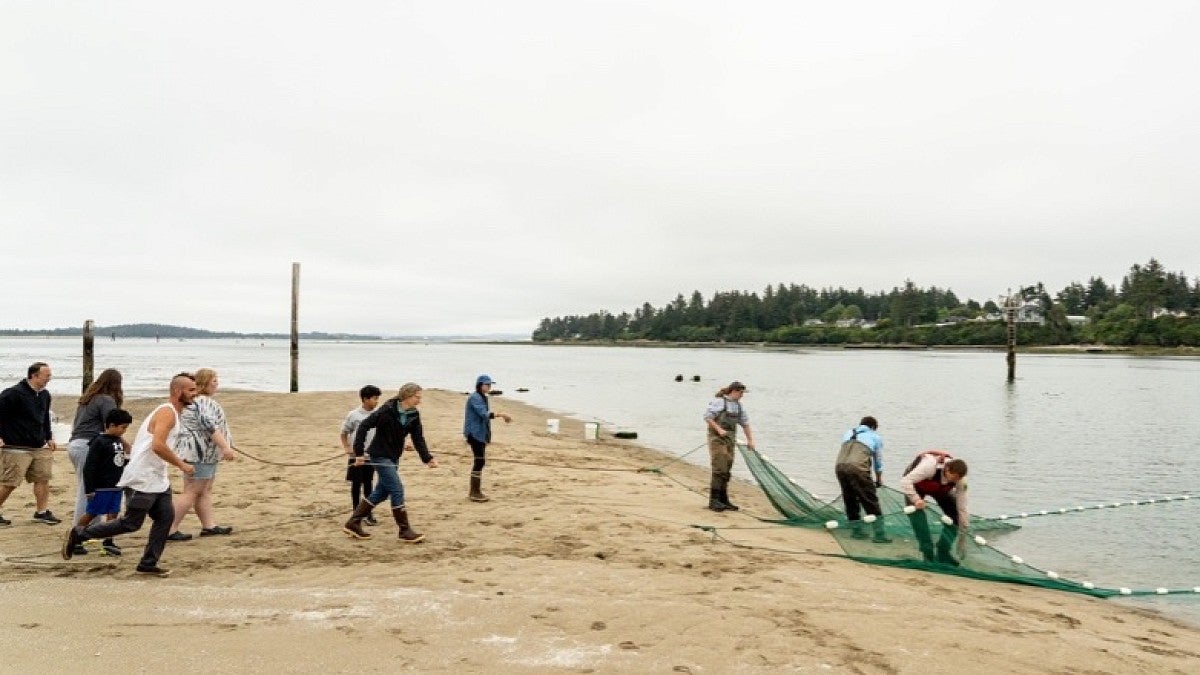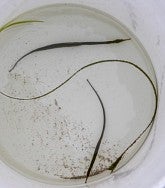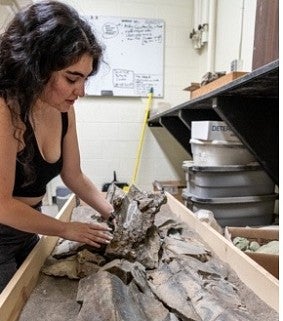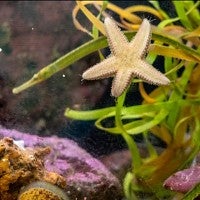
August 19, 2024 - 9:00am
A large group gathers on a quiet beach to examine marine life collected in a net.
Two captive pipefish wriggle among the eelgrass as youth and educators with the Confederated Tribes of Coos, Lower Umpqua and Siuslaw Indians examine the critters alongside with Oregon Department of Fish and Wildlife (ODFW) staff and University of Oregon educators.

Before the group releases most of the animals back into the bay, ocean education expert Trish Mace asks, “Could we have the pipefish for display?”
A few hours later, the creatures, resembling strands of eelgrass with seahorse heads, are settling into their new home in a tank at the Charleston Marine Life Center (CMLC), where a growing collection of unique organisms serve as underwater ambassadors between UO researchers, local community partners, and the public.
The center, which serves as the public outreach hub for the College of Arts and Sciences’ Oregon Institute of Marine Biology, houses several exhibit galleries filled with aquaria, hanging mammal skeletons and interactive displays such as a tidepool touch tank. It’s a place where UO scientists and students can share their discoveries with the public—and where community members can rally around the preservation and celebration of local marine life.
“Each specimen has a story behind it,” says Mace, the center’s director.
Meet Wally the Whale
One of those stories began millions of years ago.
Just two miles away from the center, a fossilized whale skull emerged from the edge of the bay, exposed as the earth around it weathered. The North America Research Group excavated the fossil and spent a decade attempting to separate it from the encasing material, or matrix.

In 2021, unable to make further progress with the tools they had, the group handed the skull over to the UO. Since then, “we’ve just been picking away at it,” says Edward Davis, associate professor and Condon Fossil Collection Curator in the Department of Earth Sciences.
Andy Quintanilla, who graduated from the UO in 2021 and now works as a lab technician focusing on fossil preparation and skeletonization, is leading a small team of undergraduate students who are preparing Wally, as the skeleton is called, for display.
“The big purpose of my work is trying to make Wally recognizable,” she says.
Preparing Wally is not only physically difficult but also mentally taxing because it isn’t always clear what is fossil and what isn’t.
“You have to look really carefully to make sure that you’re digging into matrix and not accidentally drilling into the fossil itself,” Quintanilla says.
Once Wally is ready, it will join the other skeletons on display in the CMLC to help teach visitors about the breadth of marine life that once occupied local waters.
"A lot of folks who don’t have expertise can come in and see it and feel that connection to the ancient world,” Davis says.
An ever-changing marine community
Populating the center’s many exhibits is a community effort. CMLC staff and volunteers gather many themselves, while students collect some of the organisms as part of their coursework in marine biology. Members of the Charleston community, including local fishers and ODFW staff, go out of their way to help whenever they can.When the crew of a local fishing boat found a giant Pacific octopus in one of their crab pots last year, they brought it to Charleston.
All collecting for the CMLC occurs under permit, with an eye to protecting local populations. Several local fishermen are included on the permit to help enhance what is on display. Most of the octopuses that come through the CMLC are brought in by the crew of local fishing boats when Giant Pacific Octopuses end up in their crab pots.
The cephalopods spend a few months at the center, where visitors can observe and learn about these remarkable animals, before being returned to the ocean.
The center’s approach to exhibit design reflects this emphasis on community and preservation. Unlike the single-species exhibits found in many aquariums, organisms at CMLC are grouped into tanks based on their habitats, which are organized into several “neighborhoods” throughout the museum.
“People can see the habitats to get an understanding of what lives together,” Mace says.

Deciding what to collect is no simple matter. Mace considers each organism’s growth, how they’ll get along with each other and how their interactions may change as they mature. One creature may get along with another when it’s young, for example, but those relationships can change quickly.
“All of a sudden it’s starting to look at the other one, not as a tankmate, but as food,” Mace says.
Just like the underwater habitats they represent, the exhibits are constantly changing as new creatures are collected and older inhabitants are released back into the wild.
“Even if you live here and have been here before, there are reasons to come back and see what’s new,” Mace says.
Nadia Stoker, an AmeriCorps marine science educator at the CMLC, hopes the organisms will help visitors connect with local marine life while fostering learning for all ages.
“To see the same sort of excitement from young to old all happening in this building, there’s nothing like it,” Stoker says.
—By Vishva Nalamalapu, College of Arts and Sciences
